sEMG-Based Hand Gesture Recognition Using Binarized Neural Network
Abstract
1. Introduction
2. Background
2.1. Short-Time Fourier Transform
2.2. Convolutional Neural Network
2.3. Binarized Neural Network
3. Proposed HGR System
3.1. Gestures Definition
3.2. Data Acquisition
3.3. Pre-Processing
3.4. Performance Evaluation with Network
4. Hardware Architecture Design
4.1. STFT Unit
4.2. BNN Unit
5. Hardware Implementation Results
6. Conclusions
Author Contributions
Funding
Institutional Review Board Statement
Informed Consent Statement
Data Availability Statement
Conflicts of Interest
References
- Qi, W.; Ovur, S.E.; Li, Z.; Marzullo, A.; Song, R. Multi-sensor guided hand gesture recognition for a teleoperated robot using a recurrent neural network. IEEE Robot. Autom. Lett. 2021, 6, 6039–6045. [Google Scholar] [CrossRef]
- Da Gama, A.E.F.; Chaves, T.M.; Figueiredo, L.S.; Baltar, A.; Meng, M.; Navab, N.; Teichrieb, V.; Fallavollita, P. MirrARbilitation: A clinically-related gesture recognition interactive tool for an AR rehabilitation system. Comput. Methods Programs Biomed. 2016, 135, 105–114. [Google Scholar] [CrossRef] [PubMed]
- Nsugbe, E.; Phillips, C.; Fraser, M.; McIntosh, J. Gesture recognition for transhumeral prosthesis control using EMG and NIR. IET Cyber-Syst. Robot. 2020, 2, 122–131. [Google Scholar] [CrossRef]
- Song, W.; Han, Q.; Lin, Z.; Yan, N.; Luo, D.; Liao, Y.; Zhang, M.; Wang, Z.; Xie, X.; Wang, A.; et al. Design of a flexible wearable smart sEMG recorder integrated gradient boosting decision tree based hand gesture recognition. IEEE Trans. Biomed. Circuits Syst. 2019, 13, 1563–1574. [Google Scholar] [CrossRef] [PubMed]
- Yu, Z.; Zhao, J.; Wang, Y.; He, L.; Wang, S. Surface EMG-based instantaneous hand gesture recognition using convolutional neural network with the transfer learning method. Sensors 2021, 21, 2540. [Google Scholar] [CrossRef] [PubMed]
- Miller, R.B. Response time in man-computer conversational transactions. In Proceedings of the December 9–11, 1968, Fall Joint Computer Conference, Part I; Association for Computing Machinery: New York, NY, USA, 1968; pp. 267–277. [Google Scholar]
- Kim, J.; Mastnik, S.; André, E. EMG-based hand gesture recognition for realtime biosignal interfacing. In Proceedings of the 13th International Conference on Intelligent User Interfaces, Gran Canaria, Spain, 13–16 January 2008; pp. 30–39. [Google Scholar]
- Ozdemir, M.A.; Kisa, D.H.; Guren, O.; Onan, A.; Akan, A. EMG based hand gesture recognition using deep learning. In Proceedings of the 2020 Medical Technologies Congress (TIPTEKNO), Antalya, Turkey, 19–20 November 2020; pp. 1–4. [Google Scholar]
- Samadani, A. EMG channel selection for improved hand gesture classification. In Proceedings of the 2018 40th Annual International Conference of the IEEE Engineering in Medicine and Biology Society (EMBC), Honolulu, HI, USA, 18–21 July 2018; pp. 4297–4300. [Google Scholar]
- Fajardo, J.M.; Gomez, O.; Prieto, F. EMG hand gesture classification using handcrafted and deep features. Biomed. Signal Process. Control 2021, 63, 102210. [Google Scholar] [CrossRef]
- Anil, N.; Sreeletha, S. EMG based gesture recognition using machine learning. In Proceedings of the 2018 Second International Conference on Intelligent Computing and Control Systems (ICICCS), Madurai, India, 14–15 June 2018; pp. 1560–1564. [Google Scholar]
- Oh, D.; Jo, Y. EMG-based hand gesture classification by scale average wavelet transform and CNN. In Proceedings of the 2019 19th International Conference on Control, Automation and Systems (ICCAS), Jeju, Republic of Korea, 15–18 October 2019; pp. 533–538. [Google Scholar]
- Ghalyan, I.; Abouelenin, Z.; Kapila, V. Gaussian filtering of EMG signals for improved hand gesture classification. In Proceedings of the 2018 IEEE Signal Processing in Medicine and Biology Symposium (SPMB), Philadelphia, PA, USA, 1 December 2018; pp. 1–6. [Google Scholar]
- Xie, B.; Meng, J.; Li, B.; Harland, A. Biosignal-based transferable attention Bi-ConvGRU deep network for hand-gesture recognition towards online upper-limb prosthesis control. Comput. Methods Programs Biomed. 2022, 224, 106999. [Google Scholar] [CrossRef] [PubMed]
- Pizzolato, S.; Tagliapietra, L.; Cognolato, M.; Reggiani, M.; Müller, H.; Atzori, M. Comparison of six electromyography acquisition setups on hand movement classification tasks. PLoS ONE 2017, 12, e0186132. [Google Scholar] [CrossRef]
- López, L.I.B.; Caraguay, Á.L.V.; Vimos, V.H.; Zea, J.A.; Vásconez, J.P.; Álvarez, M.; Benalcázar, M.E. An energy-based method for orientation correction of EMG bracelet sensors in hand gesture recognition systems. Sensors 2020, 20, 6327. [Google Scholar] [CrossRef] [PubMed]
- Rahimian, E.; Zabihi, S.; Atashzar, S.F.; Asif, A.; Mohammadi, A. Surface EMG-based hand gesture recognition via hybrid and dilated deep neural network architectures for neurorobotic prostheses. J. Med. Robot. Res. 2020, 5, 2041001. [Google Scholar] [CrossRef]
- Allard, U.C.; Nougarou, F.; Fall, C.L.; Giguère, P.; Gosselin, C.; Laviolette, F.; Gosselin, B. A convolutional neural network for robotic arm guidance using sEMG based frequency-features. In Proceedings of the 2016 IEEE/RSJ International Conference on Intelligent Robots and Systems (IROS), Daejeon, Republic of Korea, 9–14 October 2016; pp. 2464–2470. [Google Scholar]
- Zhai, X.; Jelfs, B.; Chan, R.H.; Tin, C. Short latency hand movement classification based on surface EMG spectrogram with PCA. In Proceedings of the 2016 38th Annual International Conference of the IEEE Engineering in Medicine and Biology Society (EMBC), Orlando, FL, USA, 16–20 August 2016; pp. 327–330. [Google Scholar]
- Montazerin, M.; Zabihi, S.; Rahimian, E.; Mohammadi, A.; Naderkhani, F. ViT-HGR: Vision Transformer-based Hand Gesture Recognition from High Density Surface EMG Signals. arXiv 2022, arXiv:2201.10060. [Google Scholar]
- Benatti, S.; Farella, E.; Benini, L. Towards EMG control interface for smart garments. In Proceedings of the 2014 ACM International Symposium on Wearable Computers: Adjunct Program, Seattle, WA, USA, 13–17 September 2014; pp. 163–170. [Google Scholar]
- Benatti, S.; Montagna, F.; Kartsch, V.; Rahimi, A.; Rossi, D.; Benini, L. Online learning and classification of EMG-based gestures on a parallel ultra-low power platform using hyperdimensional computing. IEEE Trans. Biomed. Circuits Syst. 2019, 13, 516–528. [Google Scholar] [CrossRef]
- Benatti, S.; Casamassima, F.; Milosevic, B.; Farella, E.; Schönle, P.; Fateh, S.; Burger, T.; Huang, Q.; Benini, L. A versatile embedded platform for EMG acquisition and gesture recognition. IEEE Trans. Biomed. Circuits Syst. 2015, 9, 620–630. [Google Scholar] [CrossRef] [PubMed]
- Tavakoli, M.; Benussi, C.; Lopes, P.A.; Osorio, L.B.; de Almeida, A.T. Robust hand gesture recognition with a double channel surface EMG wearable armband and SVM classifier. Biomed. Signal Process. Control 2018, 46, 121–130. [Google Scholar] [CrossRef]
- Liu, X.; Sacks, J.; Zhang, M.; Richardson, A.G.; Lucas, T.H.; Van der Spiegel, J. The virtual trackpad: An electromyography-based, wireless, real-time, low-power, embedded hand-gesture-recognition system using an event-driven artificial neural network. IEEE Trans. Circuits Syst. II Express Briefs 2016, 64, 1257–1261. [Google Scholar] [CrossRef]
- Kartsch, V.; Benatti, S.; Mancini, M.; Magno, M.; Benini, L. Smart wearable wristband for EMG based gesture recognition powered by solar energy harvester. In Proceedings of the 2018 IEEE International Symposium on Circuits and Systems (ISCAS), Florence, Italy, 27–30 May 2018; pp. 1–5. [Google Scholar]
- Pancholi, S.; Joshi, A.M. Electromyography-based hand gesture recognition system for upper limb amputees. IEEE Sens. Lett. 2019, 3, 1–4. [Google Scholar] [CrossRef]
- Cedeño, C.; Cordova-Garcia, J.; Asanza, V.; Ponguillo, R.; Muñoz, L. k-NN-Based EMG Recognition for Gestures Communication with Limited Hardware Resources. In Proceedings of the 2019 IEEE SmartWorld, Ubiquitous Intelligence & Computing, Advanced & Trusted Computing, Scalable Computing & Communications, Cloud & Big Data Computing, Internet of People and Smart City Innovation (SmartWorld/SCALCOM/UIC/ATC/CBDCom/IOP/SCI), Leicester, UK, 19–23 August 2019; pp. 812–817. [Google Scholar]
- Moin, A.; Zhou, A.; Rahimi, A.; Menon, A.; Benatti, S.; Alexandrov, G.; Tamakloe, S.; Ting, J.; Yamamoto, N.; Khan, Y.; et al. A wearable biosensing system with in-sensor adaptive machine learning for hand gesture recognition. Nat. Electron. 2021, 4, 54–63. [Google Scholar] [CrossRef]
- Franco, G.; Cancian, P.; Cerina, L.; Besana, E.; Beretta, N.; Santambrogio, M.D. FPGA-based muscle synergy extraction for surface EMG gesture classification. In Proceedings of the 2017 IEEE Biomedical Circuits and Systems Conference (BioCAS), Turin, Italy, 19–21 October 2017; pp. 1–4. [Google Scholar]
- Gravity: Analog EMG Sensor by OY Motion. Available online: https://www.dfrobot.com/product-1661.html/ (accessed on 27 October 2022).
- Ishak, A.J.; Ahmad, S.A.; Soh, A.C.; Naraina, N.A.; Jusoh, R.M.R.; Chikamune, W. Design of a wireless surface EMG acquisition system. In Proceedings of the 2017 24th International Conference on Mechatronics and Machine Vision in Practice (M2VIP), Auckland, New Zealand, 21–23 November 2017; pp. 1–6. [Google Scholar]
- Shair, E.; Jamaluddin, N.; Abdullah, A. Finger Movement Discrimination of EMG Signals Towards Improved Prosthetic Control using TFD. Int. J. Adv. Comput. Sci. Appl. 2020, 11. [Google Scholar] [CrossRef]
- Intel: Santa Clara, CA, U. Altera MAX 10 10M50DAF484C7G. Available online: https://www.intel.com/content/www/us/en/products/sku/210276/intel-max-10-10m50-fpga/specifications.html (accessed on 27 October 2022).
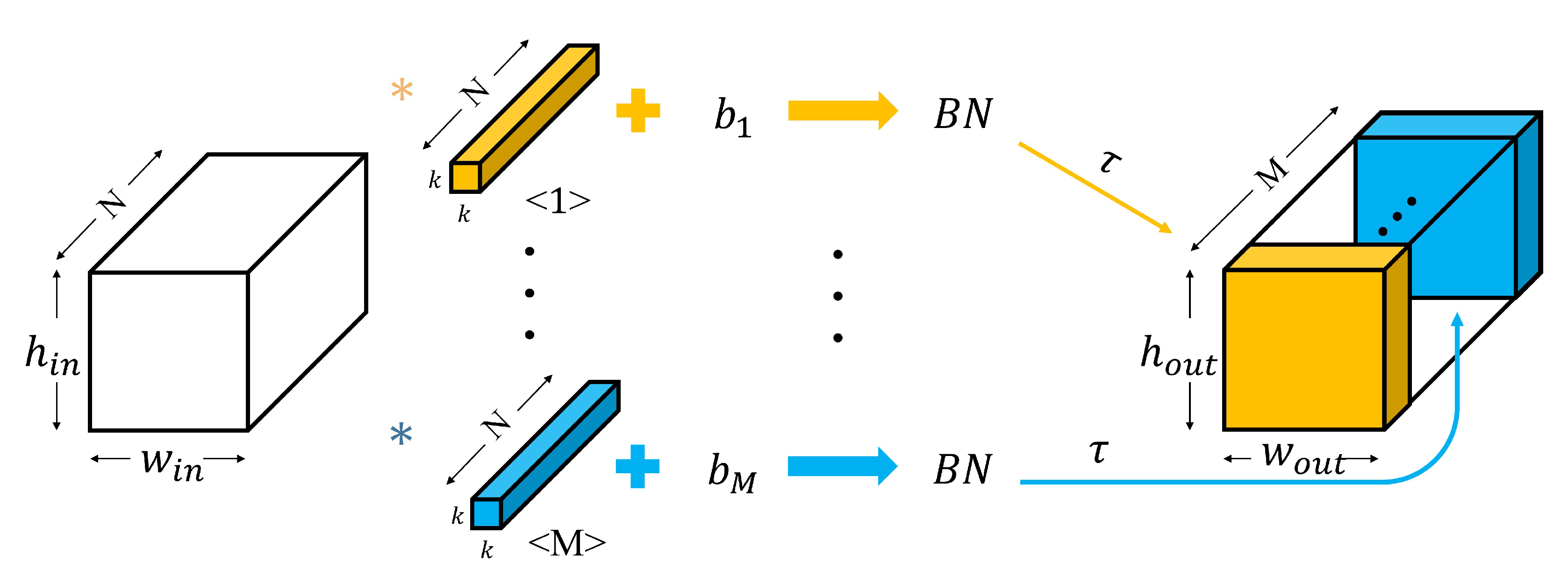
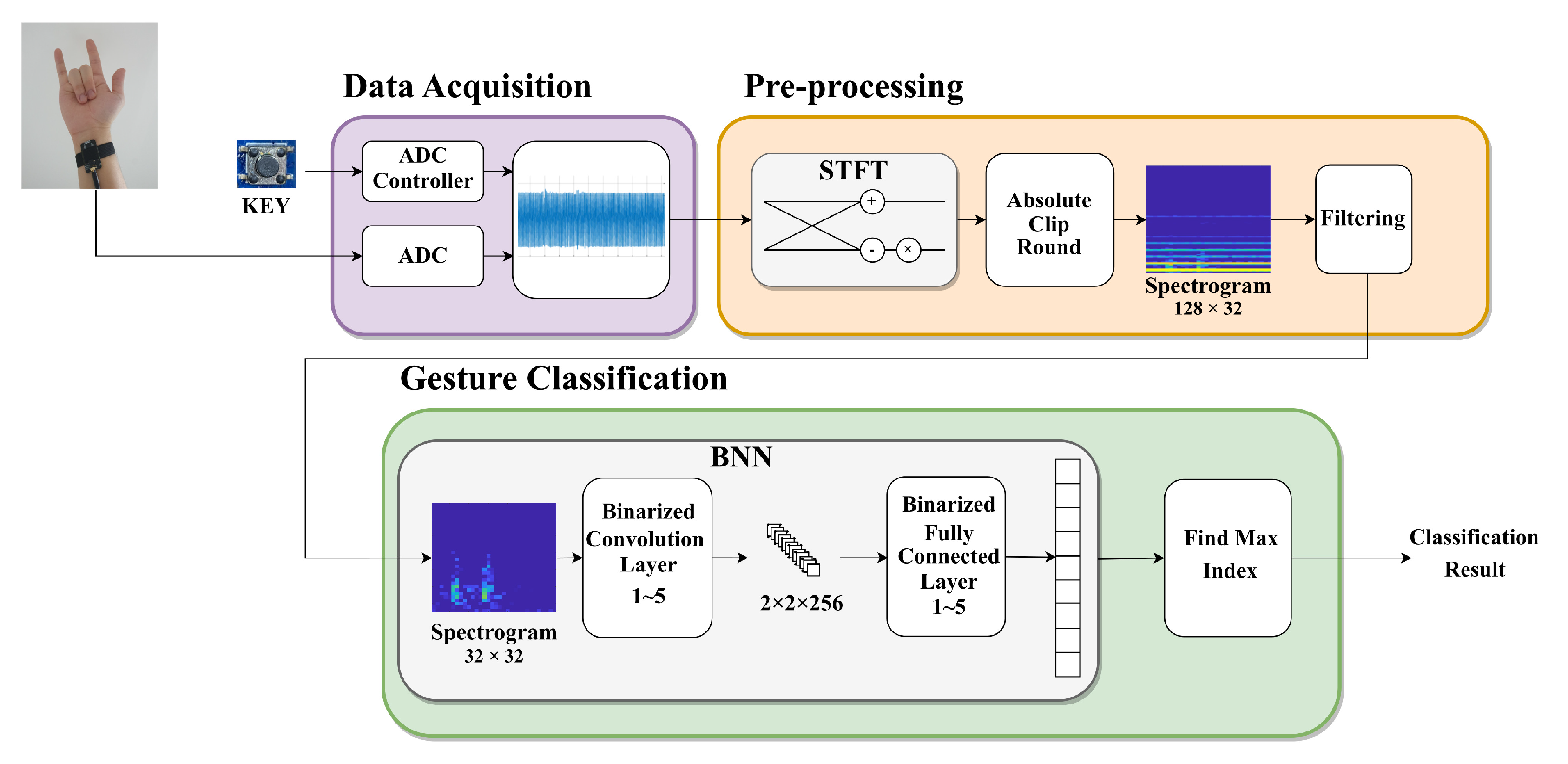


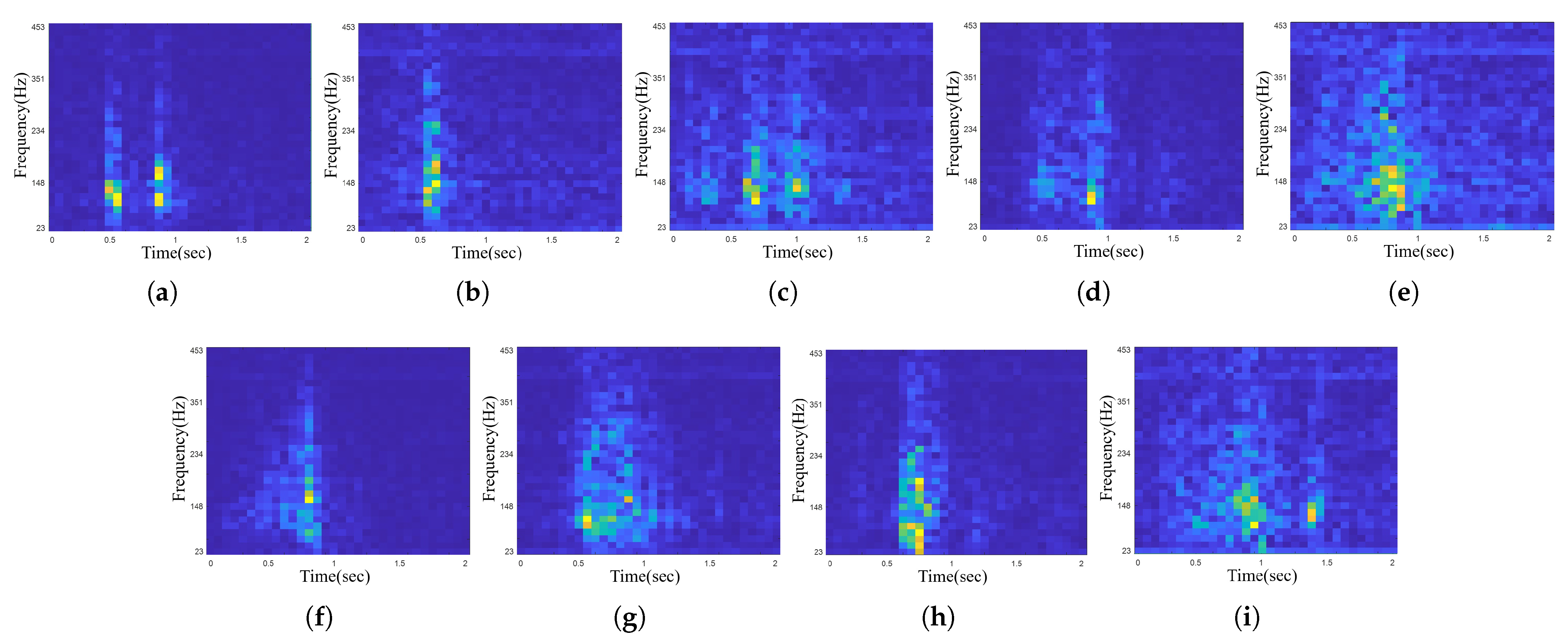
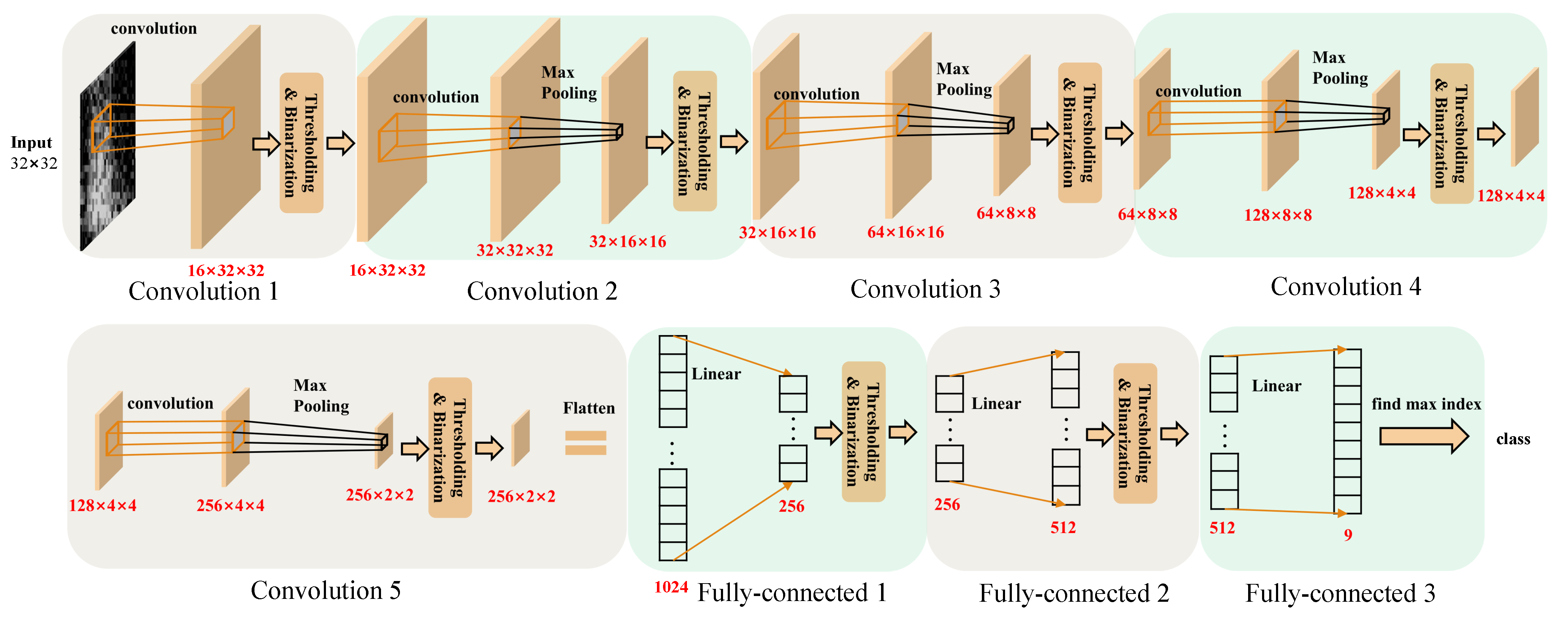
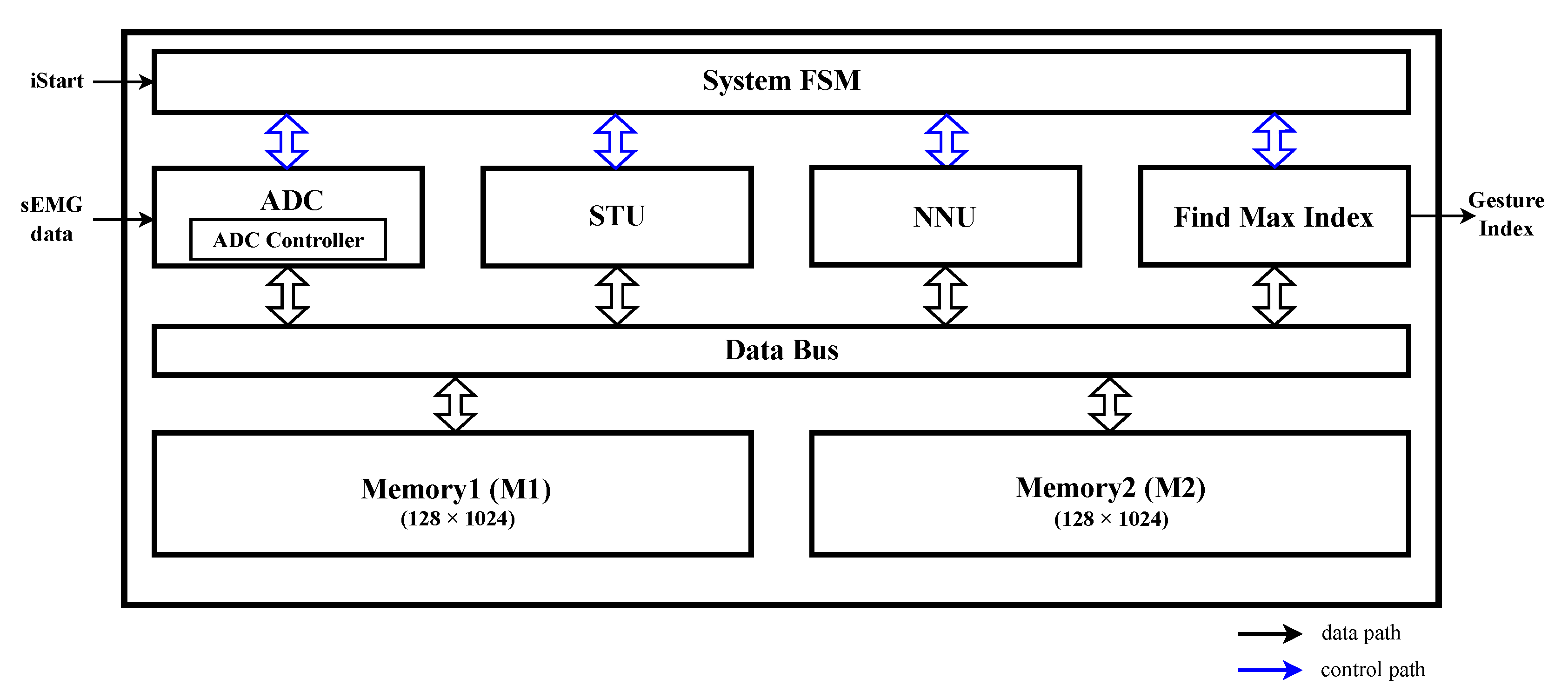
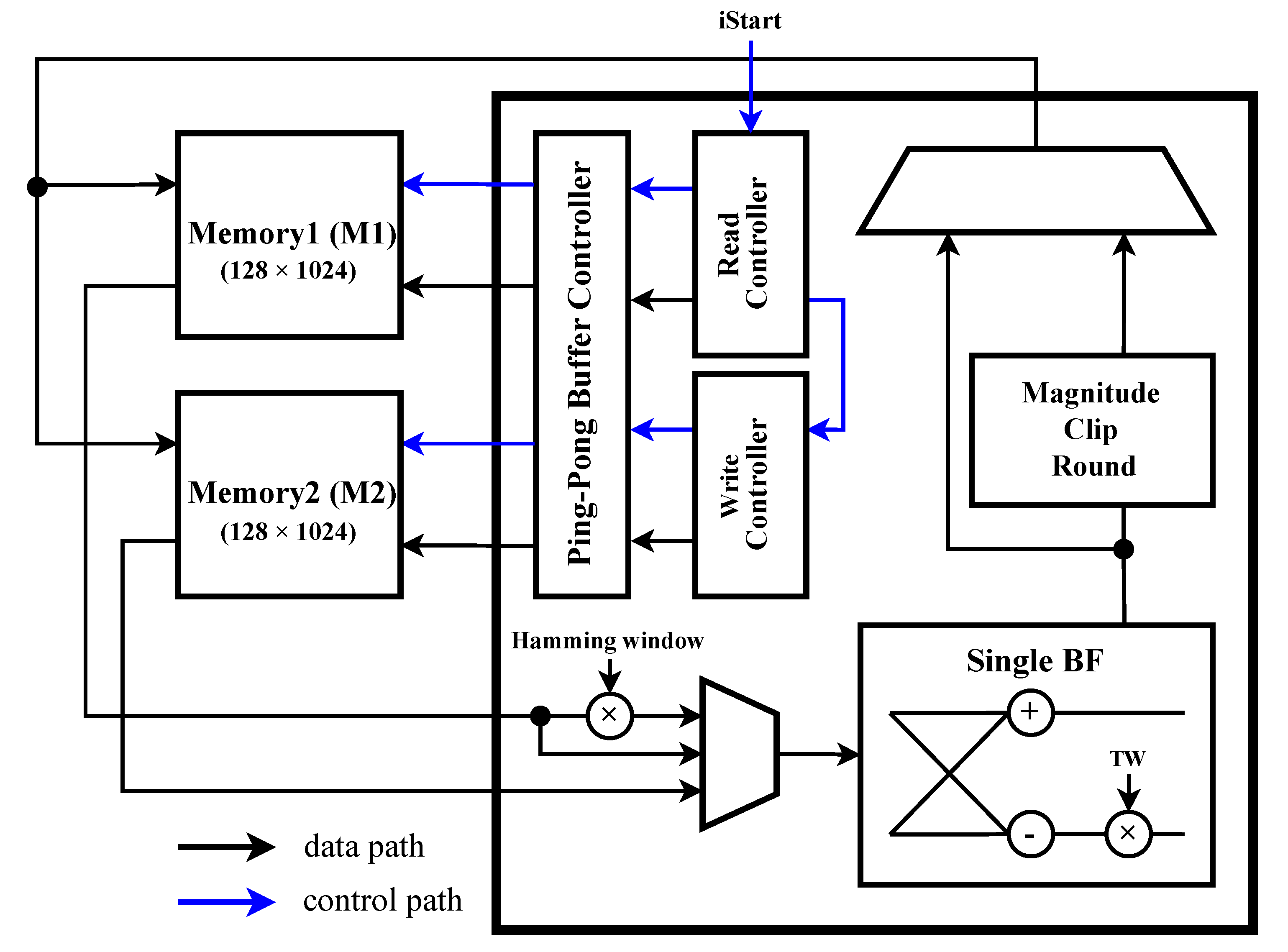
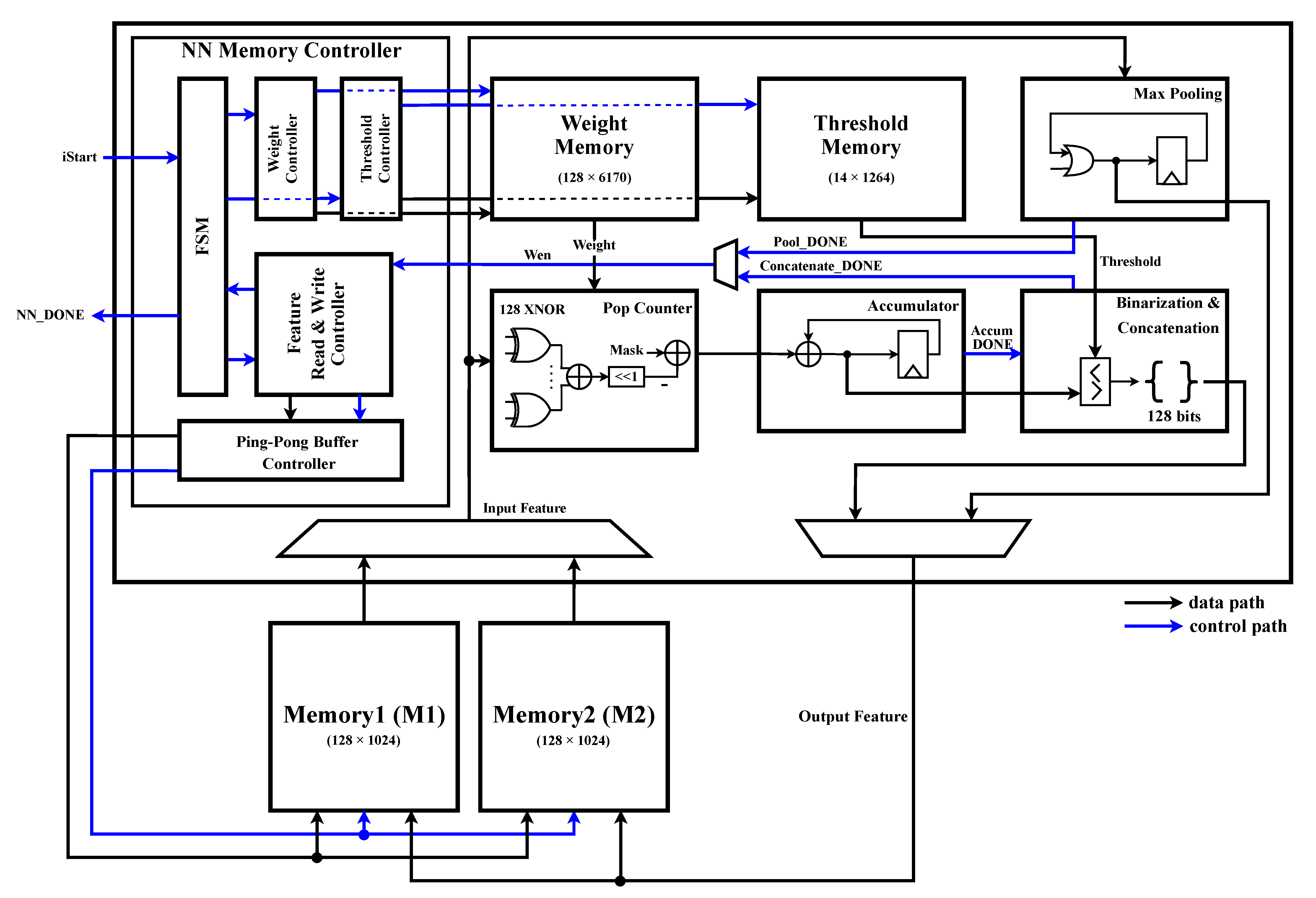
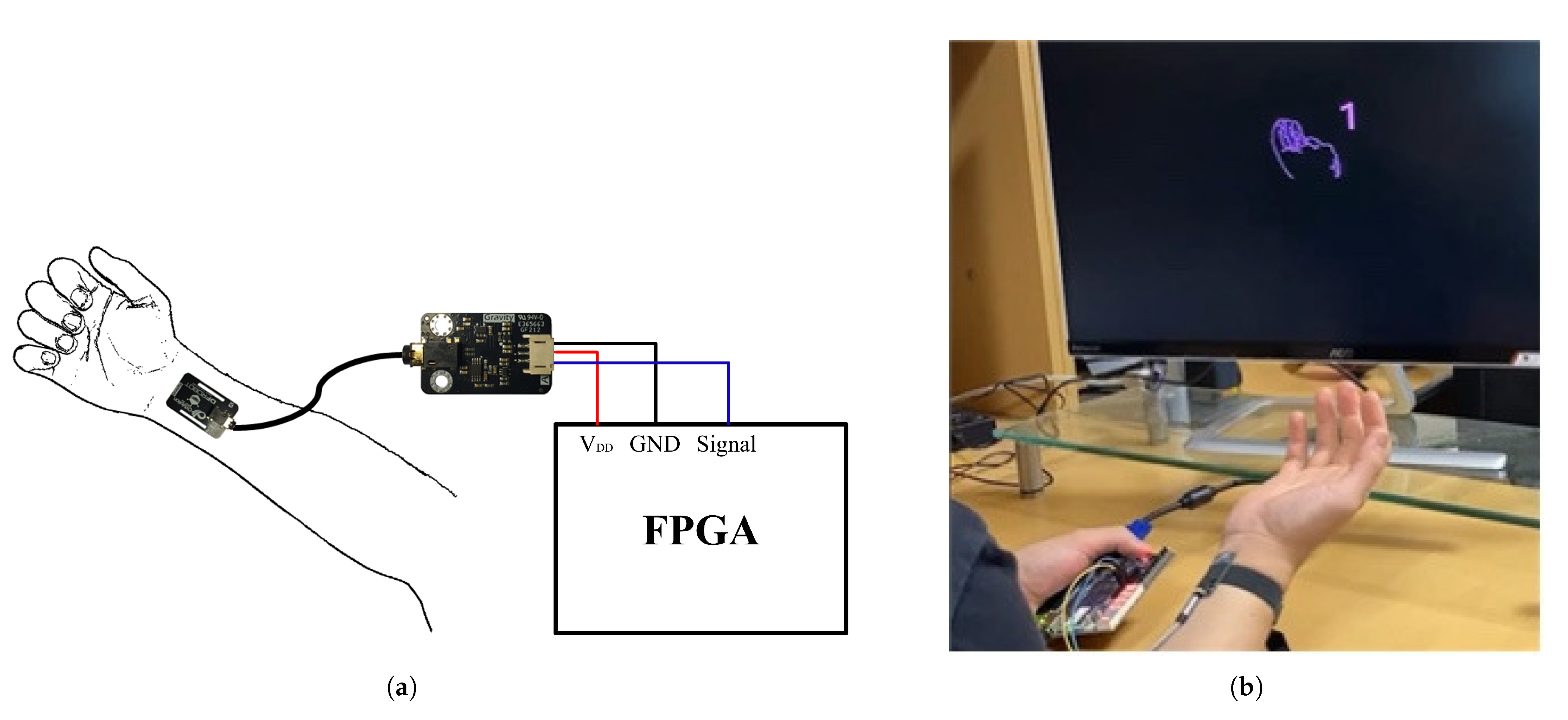
| Implementation Method | Accuracy (%) | Logic Elements |
|---|---|---|
| Equation (3) | 95.6 | 662 |
| Equation (4) | 95.4 | 61 |
| Network | #filters | #nodes | Accuracy (%) | |||||||
|---|---|---|---|---|---|---|---|---|---|---|
| C11 | C12 | C13 | C14 | C15 | F21 | F22 | F23 | F24 | ||
| 1 | 16 | 32 | 64 | 128 | 256 | 256 | 512 | 9 | – | 97.4 |
| 2 | 16 | 32 | 64 | 128 | – | 256 | 512 | 9 | – | 96.3 |
| 3 | 16 | 32 | 64 | 128 | 256 | 512 | 512 | 9 | – | 96.3 |
| 4 | 16 | 32 | 64 | 128 | 256 | 256 | 512 | 512 | 9 | 97.8 |
| 5 | 16 | 32 | 64 | 128 | 256 | 512 | 1024 | 9 | – | 96.6 |
| 6 | 16 | 32 | 64 | 128 | 256 | 256 | 256 | 1024 | 9 | 96.7 |
| 7 | 16 | 32 | 64 | 128 | 256 | 256 | 256 | 512 | 9 | 97.1 |
| Network | #filters | #nodes | Accuracy (%) | Parameters | |||||||
|---|---|---|---|---|---|---|---|---|---|---|---|
| C11 | C12 | C13 | C14 | C15 | F21 | F22 | F23 | F24 | |||
| 1 | 16 | 32 | 64 | 128 | 256 | 256 | 512 | 9 | - | 95.4 | 790,912 |
| 4 | 16 | 32 | 64 | 128 | 256 | 256 | 512 | 512 | 9 | 95.5 | 1,053,568 |
| 5 | 16 | 32 | 64 | 128 | 256 | 512 | 1024 | 9 | - | 94.9 | 1,451,648 |
| 6 | 16 | 32 | 64 | 128 | 256 | 256 | 256 | 1024 | 9 | 94.8 | 992,896 |
| 7 | 16 | 32 | 64 | 128 | 256 | 256 | 256 | 512 | 9 | 95.0 | 856,704 |
| Unit | Logic Elements | Registers | DSPs |
|---|---|---|---|
| STU | 960 | 234 | 36 |
| NNU | 1938 | 374 | 10 |
| Others | 679 | 263 | - |
| Total | 3577 | 871 | 46 |
| Memory | Width | Depths | Memory Usage (bits) |
|---|---|---|---|
| M1 | 128 | 1024 | 131,072 |
| M2 | 128 | 1024 | 131,072 |
| Hamming window | 8 | 128 | 1024 |
| Twiddle factors | 10 | 64 | 640 |
| Weights | 128 | 6170 | 789,760 |
| Thresholds | 14 | 1264 | 17,696 |
| Total | - | - | 1,071,264 |
| Unit | Computation Cycles | Computation Time (µs) (@ 50 MHz Clock Frequency) |
|---|---|---|
| STU | 1053 | 21.06 |
| NNU | 704,930 | 14,098.6 |
| Ref. | Platform | Sensor | Classification | Implementation Results | |||||||
|---|---|---|---|---|---|---|---|---|---|---|---|
| Type | Wearing Position | #Sensors | #Classes | Gesture Type | Classifier | Accuracy (%) | Computation Time | Computation Time/#Class | Power (mW) | ||
| [21] | ARM | wet | forearm | 4 | 4 | static | SVM 1 | 83.9 | 2.2 ms | 625 µs | n/a |
| [22] | RISC-V | wet | forearm | 8 | 11 | static | HDC 2 | 85 | 36 µs | 3.27 µs | 10.4 |
| [23] | ARM | wet | forearm, wrist | 8 | 7 | static | SVM 1 | 89.2 | 1 ms | 0.14 ms | 86 |
| [24] | ARM | dry | forearm | 2 | 5 | static, dynamic | SVM 1 | 92 | 10 ms | 2 ms | n/a |
| [25] | ARM | wet | forearm | 4 | 10 | static, dynamic | ANN 3 | 94 | 0.2 ms | 20 µs | 100.6 |
| [26] | ARM | wet | wrist | 4 | 5 | static, dynamic | SVM 1 | 94 | 250 ms | 50 ms | 5.1 |
| [27] | ARM | wet | forearm | 8 | 6 | n/a | LDA 4 | 94.14 | n/a | n/a | 122.4 |
| [4] | FPGA | dry | forearm | 16 | 12 | static | GBDT 5 | 90.7 | n/a | n/a | n/a |
| [28] | FPGA | dry | forearm | 8 | 9 | static | KNN 6 | 93.4 | n/a | n/a | n/a |
| [29] | FPGA | dry with gel | forearm | 64 | 13 | static | HDC 2 | 97.12 | 236.32 µs | 2.02 µs | 141.2 |
| [30] | FPGA | dry with interface 7 | forearm | 8 | 5 | static | SVM 1 | 98 | 322 µs | 64.3 µs | 3,100 |
| Proposed | FPGA | dry | wrist | 1 | 9 | dynamic | BNN | 95.4 | 14.1 ms | 1.57 ms | 91.81 |
Disclaimer/Publisher’s Note: The statements, opinions and data contained in all publications are solely those of the individual author(s) and contributor(s) and not of MDPI and/or the editor(s). MDPI and/or the editor(s) disclaim responsibility for any injury to people or property resulting from any ideas, methods, instructions or products referred to in the content. |
© 2023 by the authors. Licensee MDPI, Basel, Switzerland. This article is an open access article distributed under the terms and conditions of the Creative Commons Attribution (CC BY) license (https://creativecommons.org/licenses/by/4.0/).
Share and Cite
Kang, S.; Kim, H.; Park, C.; Sim, Y.; Lee, S.; Jung, Y. sEMG-Based Hand Gesture Recognition Using Binarized Neural Network. Sensors 2023, 23, 1436. https://doi.org/10.3390/s23031436
Kang S, Kim H, Park C, Sim Y, Lee S, Jung Y. sEMG-Based Hand Gesture Recognition Using Binarized Neural Network. Sensors. 2023; 23(3):1436. https://doi.org/10.3390/s23031436
Chicago/Turabian StyleKang, Soongyu, Haechan Kim, Chaewoon Park, Yunseong Sim, Seongjoo Lee, and Yunho Jung. 2023. "sEMG-Based Hand Gesture Recognition Using Binarized Neural Network" Sensors 23, no. 3: 1436. https://doi.org/10.3390/s23031436
APA StyleKang, S., Kim, H., Park, C., Sim, Y., Lee, S., & Jung, Y. (2023). sEMG-Based Hand Gesture Recognition Using Binarized Neural Network. Sensors, 23(3), 1436. https://doi.org/10.3390/s23031436








